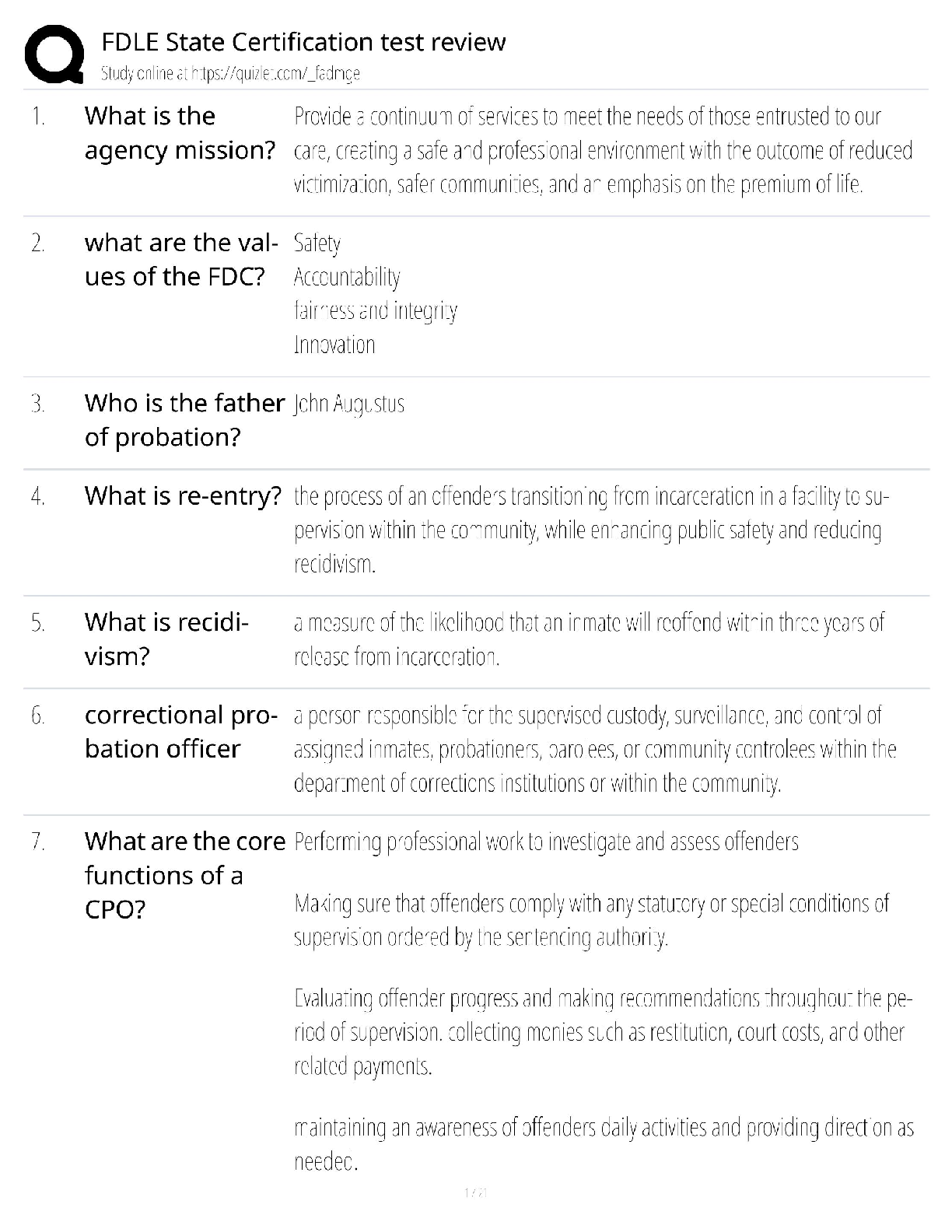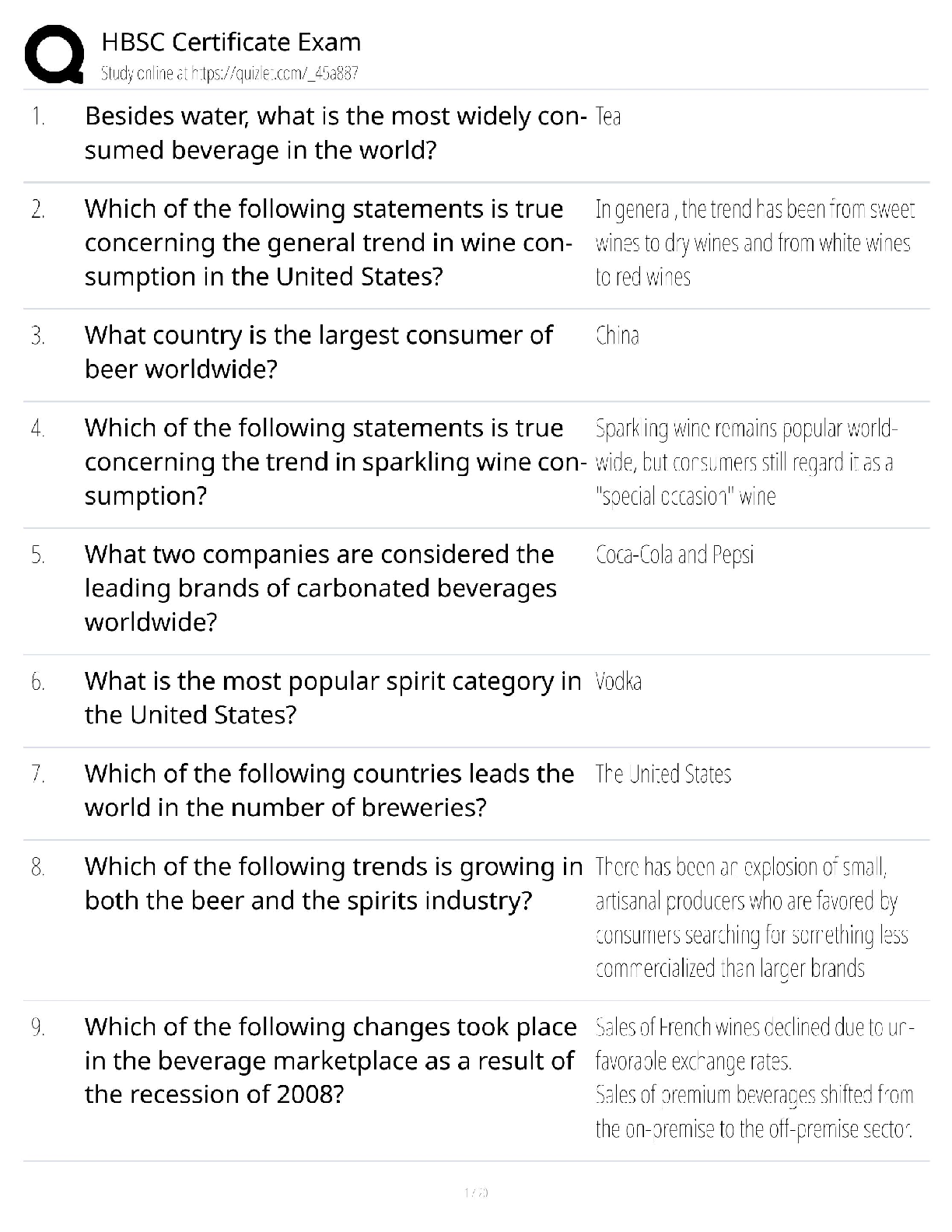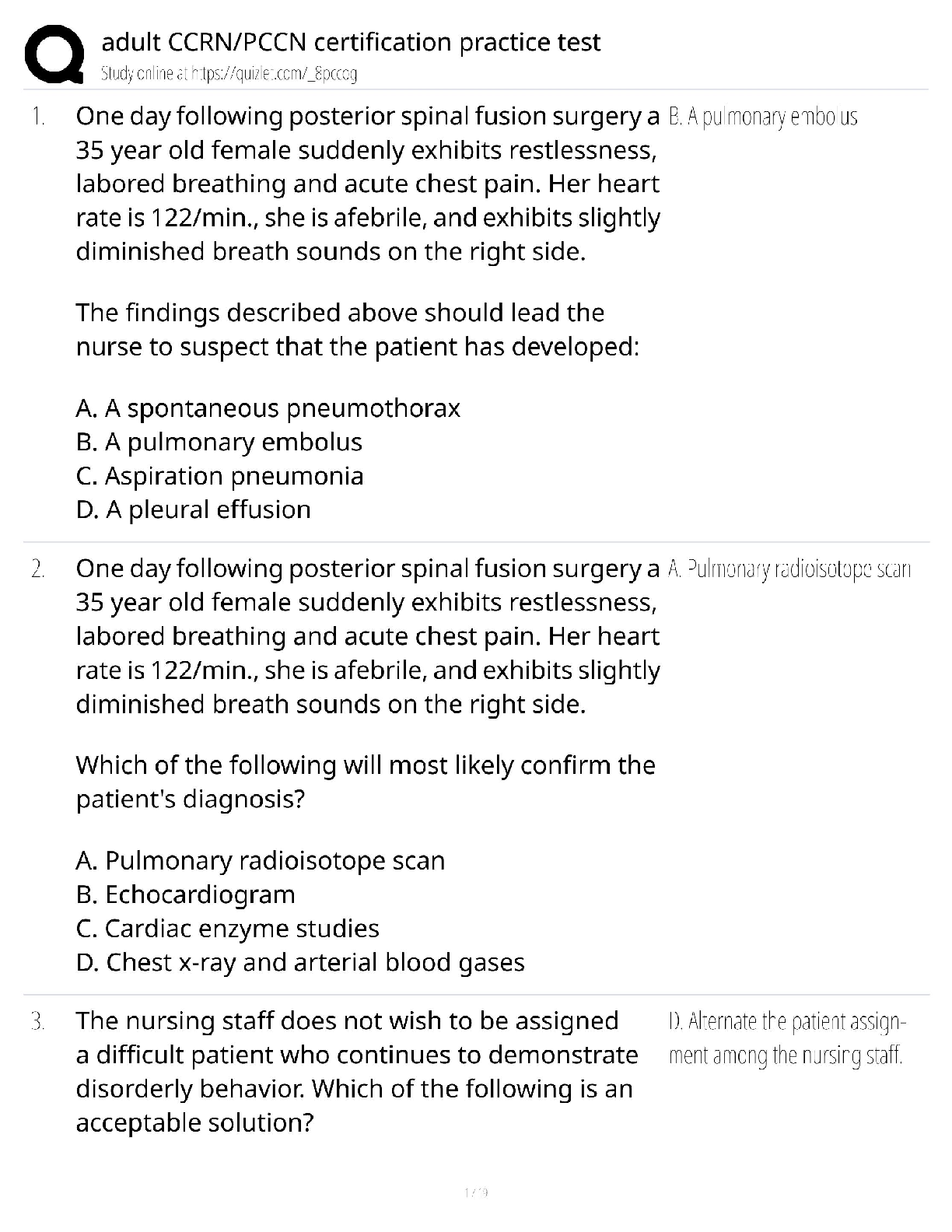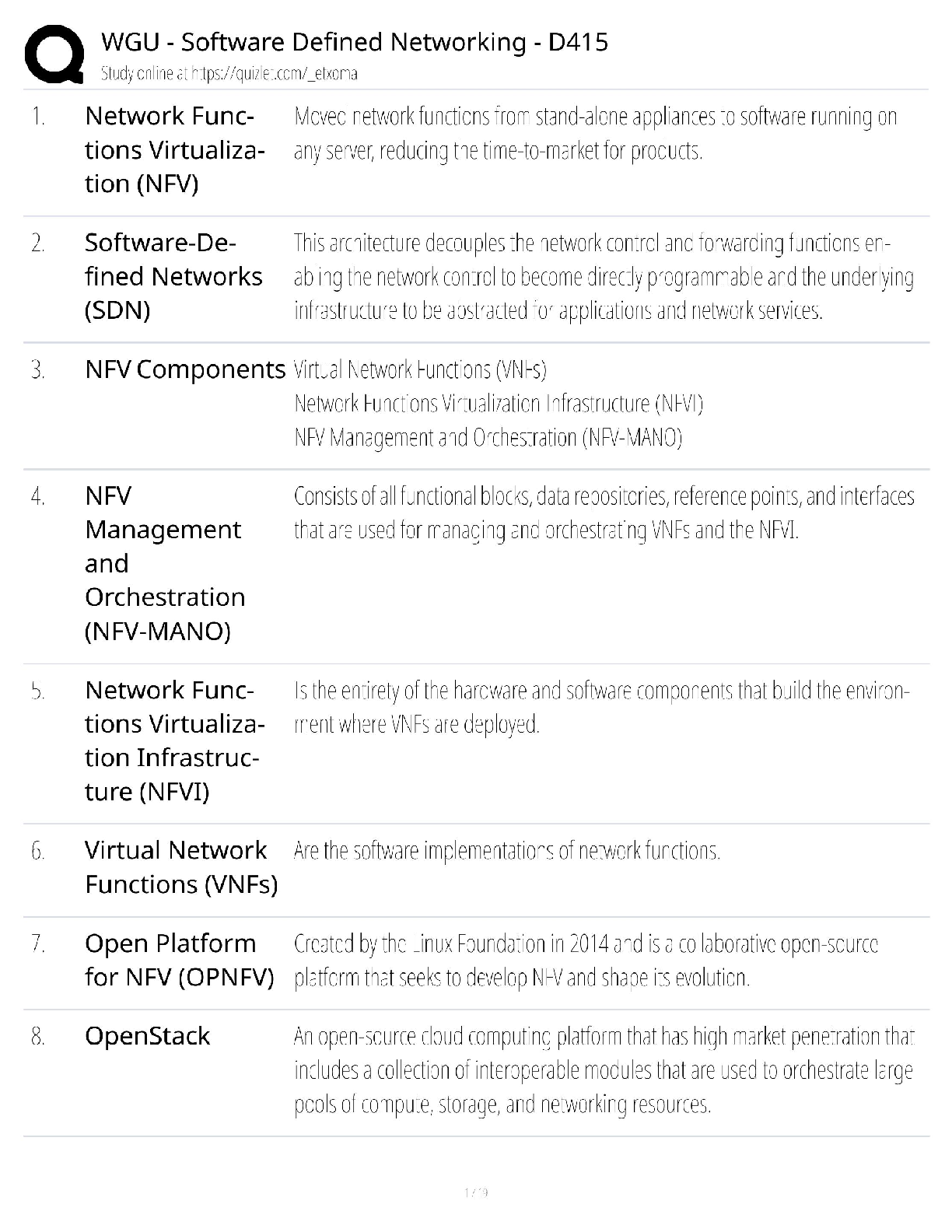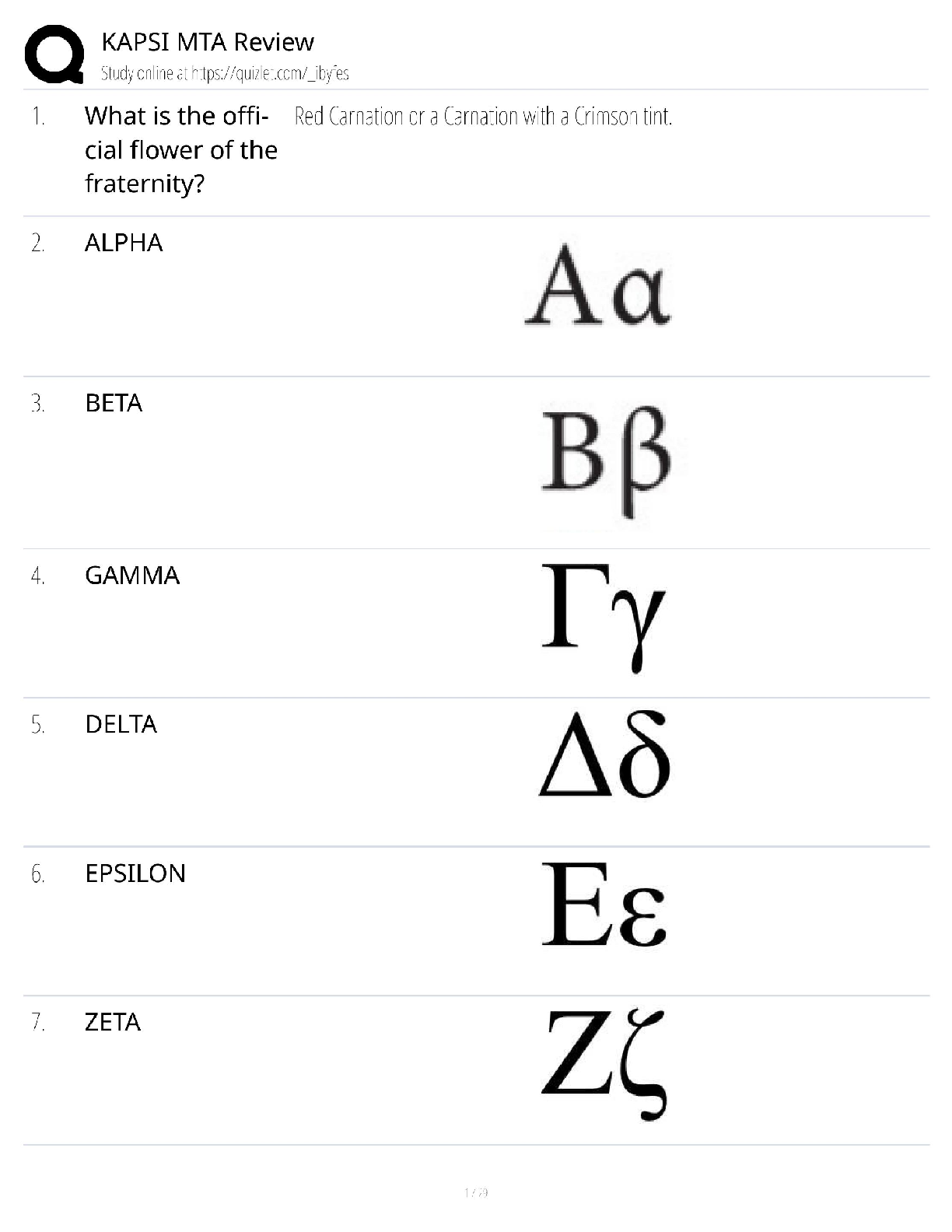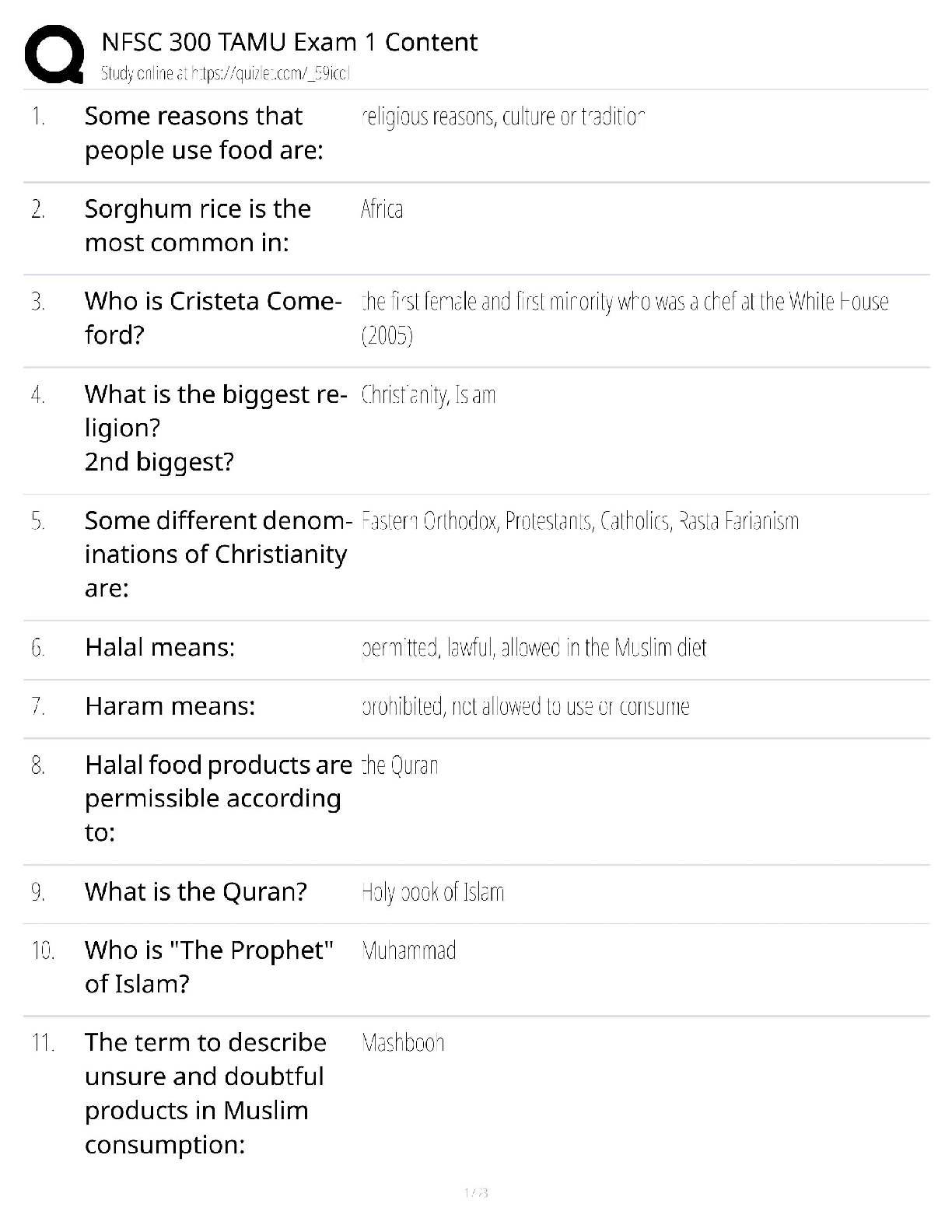*NURSING > QUESTIONS & ANSWERS > ATI- Module 3 Fundamentals: Safety and Infection / ATI- Module 3 Fundamentals: Basic Care and Comfor (All)
ATI- Module 3 Fundamentals: Safety and Infection / ATI- Module 3 Fundamentals: Basic Care and Comfort Quizzes / ATI- Module 3 Fundamentals: Fundamentals Alternate Item Format Quiz / ATI Module 4- Pharmacology
Document Content and Description Below
ATI- Module 3 Fundamentals: Safety and Infection 1) A client has a new tracheostomy. Which of the following interventions should the nurse include when performing tracheostomy care? 2) A client h ... as fallen in the bathroom. Which of the following is the priority nursing action? 3) A nurse is providing discharge education for a female client diagnosed with Chlamydia. Which statement made by the client would indicate the need for further instruction? 4) A nurse is caring for a client with a diagnosis of sepsis with a temperature of 40.8 C (105.5 F). The provider has ordered a cooling blanket. Which intervention is appropriate to delegate to an Unlicensed Assistive Personnel (UAP)? 5) A nurse is triaging clients following a mass casualty event. The nurse should place a client who has sustained fatal injuries in which of the following triage categories? 6) A nurse is positioning a client for a urinary catheterization. Which of the following nursing actions would be best in preventing musculoskeletal injuries during the procedure? 7) A nurse is caring for an older adult client with delirium. Which intervention will most effectively reduce the client’s risk for falls? 8) A fire in a first floor operating room is forcing evacuation of clients from a second floor unit to another building. Which of the following clients would have the highest priority for the charge nurse to evacuate? 9) A nurse is providing the family of a client with acquired immunodeficiency syndrome (AIDS) education in preparation for discharge. A family member asks about appropriate clean up of blood or body fluids. Which of the following is the correct response by the nurse? 10) A nurse is caring for a client when the IV infusion pump malfunctions and delivers 1 Liter of IV fluid over 2 hours. Which intervention is the priority? 11) A graduate nurse is caring for a client who is on neutropenic precautions. Which of the following actions by the nurse would require further teaching by the charge nurse? 12) A newly-licensed nurse is preparing the surgical suite for a client who has a latex allergy. Which action demonstrates a need for further education? 13) A nurse is orienting a newly licensed nurse to the operating room. Which of the following actions by the new nurse indicates a need for further education about surgical aseptic hand hygiene? 14) A client has just returned to the surgical unit after an open cholestectomy. A nurse notes the abdominal dressing is saturated with sanguineous drainage. Which of the following is the most appropriate intervention? 15) The parents of an adolescent client ask the nurse why the meningiococcal conjugate vaccine is recommended before attending college. Which of the following statements best explains the reason why college-aged students should receive this vaccine? 16) A nurse is instructing a client with a right fractured tibia on the correct technique for using a three-point gait with crutches. Which of the following should be included in teaching? 17) A nurse is educating a parent of a newborn about safety measures. Which of the following statements made by the client would indicate a need for further teaching? 18) A nurse is providing a tour of the labor and delivery unit to expectant parents. Which statement made by the mother indicates a need for further education? 19) A client with pneumonia has an oxygen saturation of 85%, heart rate of 88, respiratory rate of 22, and blood pressure of 132/88. Which of the following is the priority nursing intervention? 20) A nurse is caring for a client diagnosed with an acute anxiety disorder. Which of the following is the priority nursing intervention 21) When the nurse takes morning medications to a client, the client states “I’ve never seen that one before.” Which of the following is the most appropriate action for the nurse to take? 22) A nurse is providing staff development. The nurse understands that which of the following may impede learning? 23) A client is receiving chemotherapy and reports that the tubing has pulled apart and notices a puddle on the floor. Which of the following is the priority nursing action to take after ensuring the client is stable and appropriate tubing disposal? 24) A client being admitted to a nursing unit asks the nurse, “My friend has carpal tunnel syndrome and said I would probably get it too because of my work. What can I do to prevent it?” Which of the following statements would be the nurse’s best response? 25) A nurse is caring for multiple clients on the acute care unit. Which action demonstrates effective time management? 26) A nurse is preparing to transfer a client from the bed to a stretcher. Which action increases the nurse’s risk for injury 27) A hospital has been notified that possible bioterrorist activity has taken place at a large sporting event nearby. A nurse has been put in charge of preparing a holding area to meet the needs of victims who report headache, dizziness, anxiety and shortness of breath, and are noted to have a bitter almond odor to their breath. What medication should the nurse be prepared to administer? 28) A nurse is reinforcing teaching with an older adult about food safety in the home. Which of the following instructions should the nurse include in teaching? 29) A nurse applies restraints to a mental health client who is refusing to take his antipsychotic medication. The nurse may be charged with which of the following intentional torts? 30) A nurse is caring for a client following a right below the knee amputation. Which of the following should the nurse include in the plan of care to prevent infection? ATI- Module 3 Fundamentals: Basic Care and Comfort Quizzes 1) A nurse is teaching parents how care for their newborn. Which of the following statements indicates a good understanding of how to use a bulb syringe to suction excess mucous from the infant’s airway? 2) The parent of a two-year-old child reports feeling frustrated with the fact that her son is saying no to everything. The nurse should teach the parent that this behavior is a normal expression of the child’s desire to accomplish which of the following? 3) At a well-child visit, the parents report that their toddler occasionally touches and fondles her genital area. The parents ask the nurse if this behavior is something to be concerned about. Which of the following is a correct response 4) A nurse is completing a dietary evaluation for a client diagnosed with acute glomerulonephritis. Which of the following statements made by the client demonstrates understanding of necessary restrictions? 5) A nurse is assisting a client with bowel training. When should the nurse instruct the client to attempt defecation 6) A nurse is calculating the client’s intake and output. Based on the information below, which of the following values correctly represents the client’s total output: Sipped 8 oz. clear broth, 100 mL ice chips, Voided 450 mL, IV push pain medication 50 mL, Drank 4 oz. juice and 6 oz. hot tea, Vomited 120 mL and voided 600 mL, Jackson Pratt drain emptied 40 mL. -1210mL 7) A nurse is providing dietary education for a client with cholecystitis. Which of the following food choices made by the client indicates a need for further teaching? 8) A nurse provided discharge teaching to new parents on how to care for their newborn following circumcision. Which of the following statements by the parents indicates the need for further clarification? 9) A graduate nurse is performing ostomy care for a client with a new colostomy. Which intervention performed by the nurse indicates the need for more education? 10) A nurse is discussing the use of condoms with a female client. Which of the following statements by client represents a need for further teaching? 11) A nurse is educating a client who observes Kosher laws of food preparation. When planning menus with this client, which of the following would not be an appropriate food choice? 12) A nurse is teaching a client about dietary modifications to help control blood pressure. Which of the following food choices by the client indicates an understanding of the teaching? 13) A nurse is caring for a client after an open radical prostatectomy. Which of the following interventions is the highest priority in the immediate postoperative period? 14) A nurse is preparing a client for discharge after an anterior-posterior colporrhaphy. Which of the following statements made by the client indicates a need for further teaching? 15) A nurse is caring for a client who is receiving intermittent tube feedings. What intervention reduces the risk of aspiration 16) A nurse is caring for a client who is neutropenic. Which of the following foods are appropriate for this client? 17) A nurse is providing dietary education to a client with a new ileostomy. What foods should the nurse instruct the client to avoid in the first weeks after surgery? 18) A nurse is taking the health history of a school-age girl. Which statement by the client’s mother indicates a need for further teaching regarding the client’s nutritional status? 19) A nurse correctly understands which of the following characteristics is a possible developmental delay for a 3-month-old client? 20) A nurse has administered the first DTaP (diphtheria toxoid, tetanus and pertussis) immunization to a two-month-old infant. For which of the following symptoms should the nurse teach the parents to seek immediate medical attention 21) A nurse is providing dietary teaching to a client diagnosed with ulcerative colitis. Which of the following foods should the nurse instruct the client to avoid? 22) A client reports awaking from sleep by contractions that are occurring every five minutes and lasting 30-40 seconds. Which of the following questions should the nurse ask to assess for true labor versus false labor. 23) A nurse is educating the parents of an infant about symptoms that should be reported to the provider. What finding should be immediately reported? 24) A nurse is changing a dressing on a pre-school-aged child who has a healing wound on a lower extremity. Which of the following nonpharmacologic comfort measures would be most appropriate for this child? 25) A nurse is collecting a diet history for a client with chronic renal failure. Which food choice indicates the client would benefit from further education? 26) A nurse is educating a client on restful sleep. Which of the following statements by the client would alert the nurse that further teaching is necessary? 27) A nurse is caring for a client with a spinal cord injury who has an indwelling catheter. Which of the following is the highest priority when providing perineal care for this client? 28) A nurse needs to determine a client’s strength before ambulating. Which of the following should the nurse do? 29) A nurse is teaching a client with right-sided hemiparesis to ambulate with a quad cane. Which instructions are appropriate 30) For which of the following clients would benefit most from use of a walker? ATI- Module 3 Fundamentals: Fundamentals Alternate Item Format Quiz 1) A nurse is caring for a client with Crohn’s Disease. Which of the following foods can be included in this client’s diet? Select all that apply. -Eggs, Pasta 2) A nurse is caring for a client in Buck’s Traction. Which of the following nursing interventions would ensure effective therapy? Select all that apply 3) A nurse is caring for a client who is one-month post bariatric surgery and has been diagnosed with dumping syndrome. Which of the following recommendations is appropriate points of reinforcement in teaching? Select all that apply. 4) A nurse is caring for a client hospitalized with Guillain-Barré Syndrome. Which of the following data collected can help the nurse evaluate for complications of immobility? Select all that apply 5) An 87-year-old client has been admitted repeatedly to the acute care setting for pneumonia. The client’s family asks what measures can help prevent recurrent respiratory issues. Which of the following measures should the nurse discuss to prevent respiratory issues? Select all that apply 6) A nurse is delegating client care. Which of the following leadership functions are associated with delegation? Select all that apply. 7) A nurse is assisting a client with an advance directive. Which of the following nursing responsibilities should be included regarding advance directives? Select all that apply. 8) A nurse is managing client care. Which of the following should be implemented when prioritizing care? Select all that apply. 9) An older adult client with a history of heart failure is admitted to the hospital with a diagnosis of digoxin toxicity. Which of the following clinical findings should the nurse expect? Select all at apply 10) A client with an ileostomy reports stomal swelling along with decreased drainage of ileostomy contents. The nurse evaluates the stoma and surrounding areas by completing the following? Select all that apply 11) A nurse is reinforcing discharge teaching for a hearing impaired client. Which of the following interventions would best facilitate successful teaching? Select all that apply. ATI Module 4- Pharmacology 1) A client with a history of duodenal ulcer is admitted to the hospital with status asthmaticus. Which of the following medications should the nurse question? Select all that apply. 2) A client asks “Why can’t I take prednisone every day for my arthritis like my grandmother did?” The nurse correctly explains that corticosteroids can have which of the following adverse effects when used continuously? Select all that apply. 3) A nurse is reinforcing teaching for a client prescribed digoxin. Which of the following statements by the client demonstrates an understanding? Select all that apply. 4) A nurse is reinforcing teaching with a client diagnosed with glaucoma. The nurse should instruct the client to avoid which of the following medications? Select all that apply. 5) A surgical client in the post anesthesia care unit is receiving intravenous patient controlled analgesia (PCA) of morphine sulfate. Which of the following findings would be evidence of an interaction of anesthetic agents and the PCA infusion? Select all that apply. 6) A nurse is caring for a client who is beginning a warfarin regimen. What teaching points should be reinforced with the client about this medication? Select all that apply. [Show More]
Last updated: 3 years ago
Preview 1 out of 9 pages

Buy this document to get the full access instantly
Instant Download Access after purchase
Buy NowInstant download
We Accept:

Reviews( 0 )
$18.00
Can't find what you want? Try our AI powered Search
Document information
Connected school, study & course
About the document
Uploaded On
Feb 14, 2021
Number of pages
9
Written in
All
Additional information
This document has been written for:
Uploaded
Feb 14, 2021
Downloads
0
Views
102



.png)






.png)



